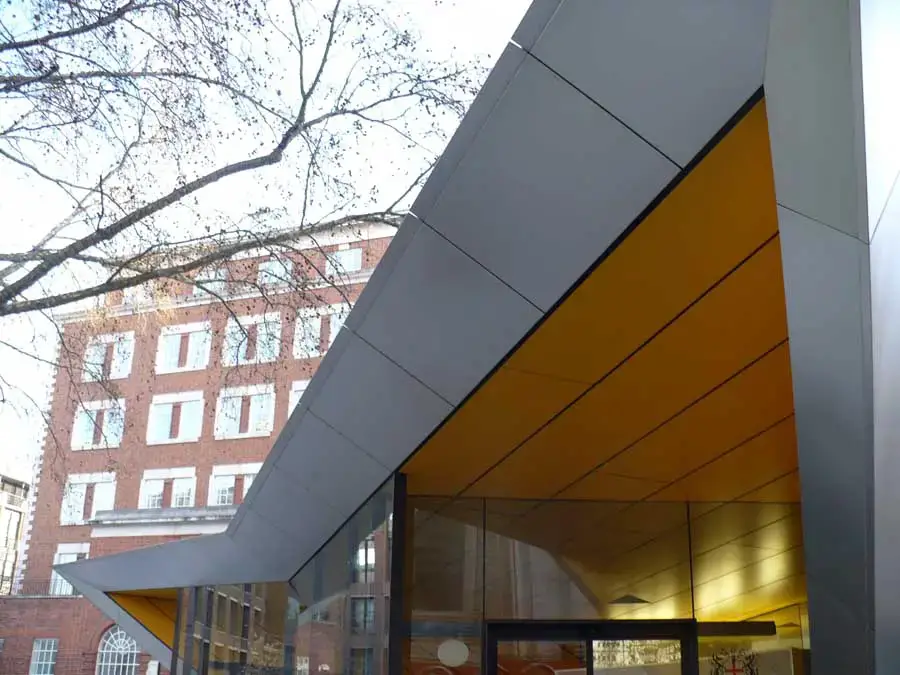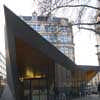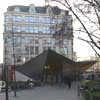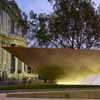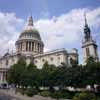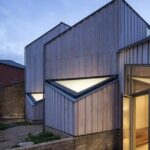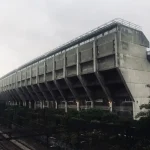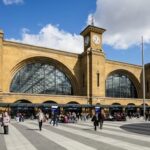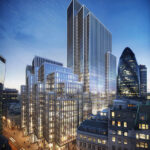St Pauls Cathedral Information Centre, EC4 Building, Kiosk Photos, Architect, Images
St Paul’s Visitor Centre London
City of London Visitor Centre at St Paul’s Cathedral design by make architects, UK
5 Apr 2011
Date built: 2007
Design: make architects
Address: St Paul’s Churchyard, London EC4M 8BX
Phone: 020 7606 3030
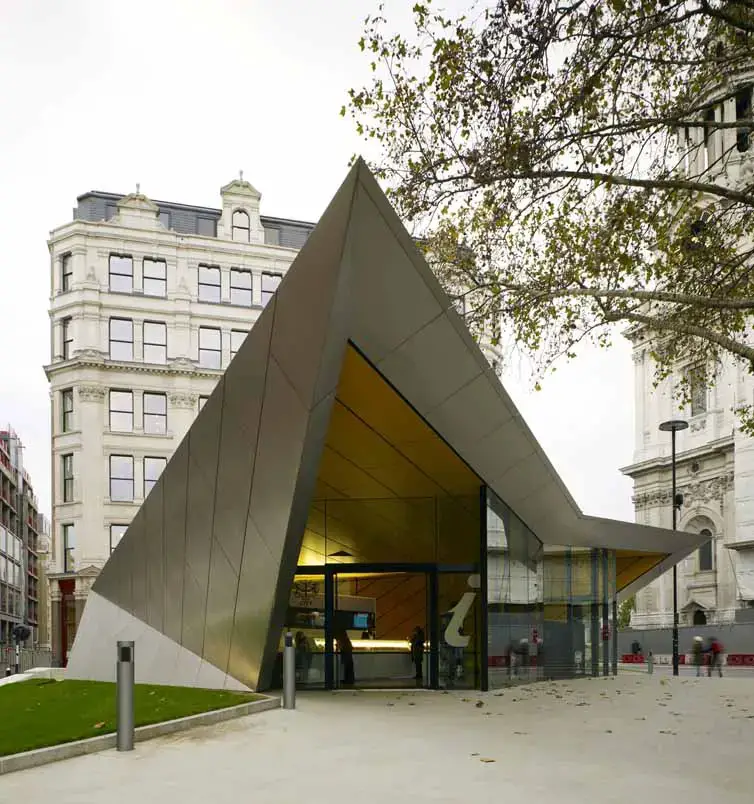
building image © make architects
City of London Information Centre
Opening hours (correct at time of last check, Apr 2014):
Monday to Saturday 9.30am-5.30pm
Sunday 10am-4pm
The new City of London Information Centre introduces a dynamic contemporary structure to an area of exceptional architectural and urban heritage. Destined to become a local landmark in its own right, this exciting new building provides all the facilities required to offer a state-of-the-art information service to the millions of people who pass through the area each year.
Replacing a circular kiosk originally designed for the Festival of Britain, the new Information Centre is situated to the south-west of the South Transept of St Paul’s Cathedral and lies on what has fast become one of London’s principal tourist routes. The opening of the Millennium Bridge has directly connected St Paul’s and the City with the South Bank and Tate Modern, and this major north-south flow of pedestrian movement is complemented by equally substantial east-west pedestrian traffic along St Paul’s Churchyard and Cannon Street.
The sensitivity and prominence of the site have combined to pose a unique design challenge. Extensive analysis of the context and lines of sight informed the positioning of the new Information Centre, with the final location ensuring that the building does not impinge on key views of St Paul’s but maintains a presence within the immediate area. The building also addresses the Cathedral in such a way as to define a new, enlarged public arrival space at the top of Peter’s Hill.
In form, the new City of London Information Centre building combines simplicity and efficiency of structure with a distinctive visual impact. The triangular plan has evolved from a consideration of the principal movement of pedestrians around the site, while the orientation and profile of the building establish an intriguing dialogue with St Paul’s. The new structure quite literally looks up to its prestigious neighbour and opens out to embrace the people who approach it.
A folded metallic envelope wraps 140m2 of internal accommodation, lending the building an angular profile and an air of lightness akin to that of a paper aeroplane. This aerodynamic effect is enhanced by the sloping roof which rises from 3m at the rear staff entrance point to 5m at the public entrance.
The large spans and cantilevers required have been achieved using a steel frame braced by a structural ply skin and clad in stainless steel panels. This solution minimises the thickness of the structural envelope – an important consideration in a building of this scale. In addition, the sensitive and restricted nature of the site made a rapid construction method highly desirable. Accordingly, the steel frame was prefabricated in 2 separate sections which were craned onto the site at night and assembled over the course of a couple of days.
The structure is clad in a specially manufactured system of 220 pre-finished stainless steel panels. This subtly reflective surface provides a striking counterpoint to the stonework of St Paul’s, and the panelisation of each elevation emphasises the crisp angularity of the folded form. By contrast, the building interior is lined with a tessellation of 174 vivid yellow panels formed from Trespa, a recycled timber product.
This bright and compact interior conceals a host of high-tech equipment necessary for providing a state-of-the-art information service to visitors. Public facilities are located at the widest part of the triangular plan, and are separated from the staff facilities beyond by a specially-designed information desk.
The City of London Information Centre building meets exacting environmental standards and has been engineered to exceed current Part L targets for CO2 emissions by 20 per cent. The computer and audio-visual equipment housed within the building generates a significant heating load; accordingly, the interior environment is regulated using borehole heating and cooling by way of pipes sunk 60m into the ground.
In addition to being highly effective, the unobtrusiveness of this geothermal system is particularly advantageous for such a highly sensitive site. Since the public part of the building is accessed by large sliding doors, heating and cooling are restricted solely to areas occupied by staff. This strategy will ensure a comfortable environment for staff at all times, while the environment in public areas will be tempered by the overspill of heated or cooled air.
The full-height glazed frontage ensures that the public front-of-house area is bathed in daylight, but is orientated to avoid excessive solar gain. Natural lighting of the interior is further assisted by a series of triangular rooflights, and all artificial lighting is regulated by daylight sensors which raise and lower light levels in response to changing conditions. The building envelope is highly insulated and the sloping roof facilitates efficient rainwater collection.
Ken Shuttleworth, of Make Architects, said: “Creating a new building for such a high-profile and historically sensitive site has been an immense privilege and a fascinating design challenge. Sean and his team have produced a strikingly contemporary design which engages with its context and sets up a new dialogue with St Paul’s opposite. The result is a welcoming and accessible new building which provides all the state-of-the-art information resources needed to assist people in getting the very best out of this incredible city.”
Sean Affleck, of Make Architects, said: “For me, one of the most fascinating things about this project is that it has been a catalyst for re-examining the whole area around St Paul’s, and working to transform it into a dramatically improved, pedestrian-friendly and genuinely public space. We’re particularly proud to have been involved in such a significant intervention in one of London’s most important urban quarters.”
City of London Information Centre – Building Information
Make Architects project team: Sean Affleck, David Picazo, Matthew Seabrook, Ken Shuttleworth
In collaboration with: Stuart Lipton/Chelsfield Partners
Client: The City of London Corporation
Consultants: Arup, Davis Langdon, Skanska, Unit 22
St Paul’s Information Centre building photographs from make architects 2007
St Paul’s Information Centre architects : make
Location: City of London Information Centre, Saint Paul’s Church Yard, London, England, UK
London Buildings
Contemporary London Architecture
London Architecture Designs – chronological list
London Architectural Tours by e-architect
London Buildings by make architects
Heart of East Greenwich

image : GMJ © make architects
Monument Building
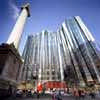
image © make architects
St Pauls Cathedral Architect – Christopher Wren
St Pauls Cathedral context : Paternoster Square
60-70 St Mary Axe
Design: Foggo Associates Architects
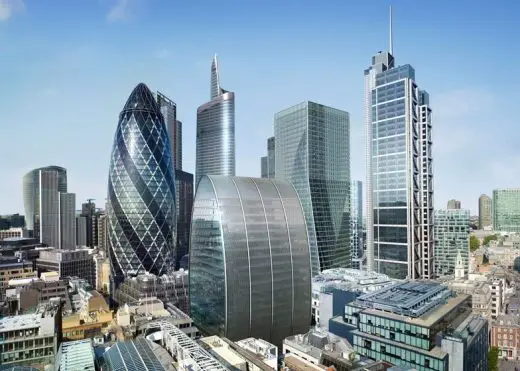
image courtesy of the architects
60-70 St Mary Axe Building
Comments / photos for the City of London Information Centre – St Pauls Architecture page welcome.

